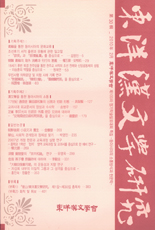학술논문
朝鮮前期 園林文化의 한 局面
이용수 167
- 영문명
- An Aspect of the Garden Gulture in the Early Chosun Period
- 발행기관
- 동양한문학회(구 부산한문학회)
- 저자명
- 이종한(Lee Jong-Han)
- 간행물 정보
- 『동양한문학연구』東洋漢文學硏究 第31輯, 233~259쪽, 전체 27쪽
- 주제분류
- 어문학 > 한국어와문학
- 파일형태
- 발행일자
- 2010.08.30
6,040원
구매일시로부터 72시간 이내에 다운로드 가능합니다.
이 학술논문 정보는 (주)교보문고와 각 발행기관 사이에 저작물 이용 계약이 체결된 것으로, 교보문고를 통해 제공되고 있습니다.

국문 초록
朝鮮前期의 한문학사는 당시 문인들을 勳舊·士林으로 나누는 구도로 논의되어 왔다. 본고에서는 이러한 시각을 통해 두 집단의 대별적인 측면을 주목해온 것을 반성하고 그들이 공유했던 부분들을 ‘원림문화’를 통해 고찰해 보았다. 그리고 대상 인물들을 成宗朝에 서로 다른 문학적·정치적 성향을 보인 것으로 논의된 ‘勳舊’와 ‘新進士類’에 해당하는 인물들로 선택했다. 이들의 일상과 문학에서 원림 문화가 자리잡고 있는 양상을 통해 두 문학 담당층의 공유점들을 확인해 보았다. 당시 원림 문화는 ‘훈구’와 ‘신진사류’의 일상 속에서 공통적으로 향유되었다. 서거정과 김종직은 자신의 가택에 별도로 화원을 조성했으며 이를 보고 느낀 바를 시문으로 나타내기도 했다. 또 강희맹과 조위도 자신의 원림에 花樹을 직접 재배했었고, 김굉필도 평소에 산수에 대한 애호가 깊어서 별서를 따로 지어서 그 곳에 원림을 조성했다는 기록이 확인된다. 조선 전기의 문인들이 원림을 문학적 소재로 대할 때에도 서로 유사한 양상이 확인되었다. 즉, 기존의 시각을 따르자면 훈구의 경우 관각적 화려함에 기반한 神仙思想이 내재된 표현, 신진사림의 경우 주자학을 의식한 心性陶冶와 관련된 표현이 서로의 문학이 지니는 대별적인 특징들이었다. 하지만 원림에 대한 문학에서는 두 집단이 이러한 표현들을 함께 사용하고 있음을 확인할 수 있었다. 이렇게 고찰되어진 부분들은 기존의 ‘훈구’와 ‘신진사류’를 二分해서 대별적으로 보는 시각으로는 파악하기 힘든 특징들이다. 물론 원림이 그 특성상 당시의 인물들에게 문화적 산물로서 향유되는 것이 그저 자연한 현상일 수도 있다. 그러나 그 속에서 엿보이는 전기 문인들의 일상적 생각과 표현에서 대립이 아닌 공유점이 찾아지는데 의의를 둘 수 있다. 그리고 훈구에서 사림으로 이어지는 과정 전체에서 대상 인물들을 아우르지 못한 점에도 한계가 있다. 하지만 대상 시기가 훈구와 사림의 선구인 ‘신진사류’가 만나기 시작하는 시점이므로 이 부분에서 발견되는 접점에도 의미가 없진 않을것이다.
영문 초록
The dualistic structure which divides the literati into the two group, Hungu(勳舊) and Salim(士林) has made many discussions about the history of the literature of the early Chosun period. This study reflects the tendency that some researches have focused on each groups' different characters, and tries to find the sharing part of the two groups. Hungu(勳舊) and New scholar-officials(新進士類) in the reign of king Seong-jong(成宗), who have been researched as having contrary literary and political characters, are involved in this study. The
sharing parts between two groups are searched by focusing on how the garden culture are enjoyed in their daily lives and literature. At that time the enjoyment of the garden culture were common to Hungu(勳舊) and New scholar-officials(新進士類). Seo Geo-Jeong(徐居正) and Kim Jong-jik(金宗直) grew their gardens and wrote many poetries with the appreciation of their gardens. Kang Hi-maeng(姜希孟) and Jo We(曺偉) also grew trees and flowers in their own garden, and there are some records saying that Kim Goeng-pil(金宏弼) liked the scenery of nature so much that he built some cottages and grew gardens near them. When the garden is regarded as literary material, similar aspects are found between them. The existing study says about each groups' literary characters that Hungu(勳舊) often uses the expressions implying the idea of immortals(神仙思想) that are from the splendidudy says wan-gak(館閣) literature, and Salim(士林) often uses the expressions implying the training of mind(心性陶冶) that are from the Zhuxi studies. However, these expressions are used altogether when they
see garden as a literary material. These parts can rarely be found in the view focusing on the contrary points
between them. The fact that they enjoyed the garden culture together would be a natural cultural phenomenon, but it would be significant that we can find out the similar things, not the contrary things in their daily thoughts and literary expressions. There's a limit in this study that it can't involve the whole people in the course in which the people in charge of literature are changing from Hungu(勳舊) to Salim(士林). However, the time this study focuses on is the beginning point when the two groups start to meet each other, so the sharing
point between them would be meaningful.
목차
Ⅰ. 序論
Ⅱ. 朝鮮前期園林文化의 盛行
Ⅲ. 朝鮮前期文人의 園林文化享有
Ⅳ. 結論
키워드
해당간행물 수록 논문
- 朝鮮前期 園林文化의 한 局面
- 峿堂 李象秀의 『史記』 評述에 대하여
- 『천주실의』에 대한 문학적 접근
- 白雲 沈大允의 儀禮正論에 대한 小考
- 조선후기 영남선비들의 여행과 공간감성
- 18세기 文學觀의 변화와 ‘개인’과 ‘개체’의 발견(1)
- 「遊金剛錄」에 나타난 再思堂 李黿의 산수 인식과 그 정신사적 의미
- 전근대 동아시아 敍事學의 지평과 한국 고전소설의 위상
- 佔畢齋 金宗直에 대한 退溪 李滉의 評價
- 점필재 김종직 연구에 대한 반성적 전망
- 동아시아 海洋神仙문화의 성립과정과 그 경로
- 耳溪 洪良浩의 書論 小考
- 睡軒 權五福의 삶과 정신 지향
- 晦峰 河謙鎭의 『國性論』분석
- 조선후기 누정기의 특징적 면모
- 少陵家의 使行 經驗과 詩的 形象化
참고문헌
교보eBook 첫 방문을 환영 합니다!

신규가입 혜택 지급이 완료 되었습니다.
바로 사용 가능한 교보e캐시 1,000원 (유효기간 7일)
지금 바로 교보eBook의 다양한 콘텐츠를 이용해 보세요!





